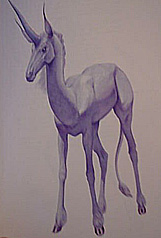Unicorns
Origins
Reverend Kenney started learning about the history and myth behind unicorns when she took an art history course in college. She continued to learn more when she visited the San Diego Wildlife Animal Park several years ago.
Quoted from Reverend Kenney
I didnt really know anything about unicorns until I took an art history course. I began to see images of unicorns in western art, much of which came out of the Renaissance, particularly in tapestry. The interpretation that was always given usually youd see a fair young maiden and a unicorn together . Usually it symbolized purity. The unicorn was always white.
I began doing a bit of research and in at least three places in the Bible there are three references to unicorns. In some translations of Genesis, the unicorn was the first animal created. The image there again interprets into a symbol of purity. But this was strictly the western unicorn. I knew the unicorn also existed in Chinese culture and meant a very different thing.
Last time I heard it discussed was at the San Diego Wildlife Animal Park. When we were traveling through the park and the tour guide stopped and asked us to look at a very particular kind of animal. It had two horns but if you were looking at the animal from the side, it looked like it had one horn. Since the animal came from the same countries where unicorn mythology came up, it might be that this animal is why unicorns exist.
Collectors comments
The explanation for unicorns given by the animal parks tour guide is confirmed by other sources that also reason that Europeans probably had a quick glance at a unicorn-like animal that looked like it had one horn from the side. The only difference in the source I found (www.avians.net/paragon/unicornessay.htm), is that the author of the essay claims that the unicorn-like animal actually had a spiral horn, much like the one pictured below.

